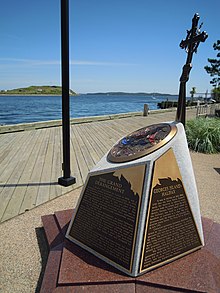Georges Island (Nova Scotia)

Georges Island Photo: Jeff Vienneau
Georges Island (named after George II of Great Britain) is a glacial drumlin and the largest island entirely within the harbour limits of Halifax Harbour located in Nova Scotia's Halifax Regional Municipality. The Island is the location of Fort Charlotte - named after King George's wife Charlotte. Fort Charlotte was built during Father Le Loutre's War, a year after Citadel Hill (Fort George). The island is now a National Historic Site of Canada.[1]
Contents
1 History
2 Today
3 See also
4 References
5 External links
History

Fort Charlotte on Georges Island
The island was originally named île à la Raquette which means Snowshoe Island. For a brief time, the Island was known as île d'Enville, named after the leader of the great Duc d’Anville Expedition who was buried on the island for a number of years. In 1749, the island was named "George Island" after King George II, and then finally, in 1963, it was renamed "Georges Island".
Upon the arrival of Edward Cornwallis and the outbreak of Father Le Loutre's War, fortifications were established on Citadel Hill (Fort George) (1749) and Georges Island (Fort Charlotte) (1750).

Monument to Imprisoned Acadians at Bishops Landing, Halifax, overlooking Georges Island
During the Seven Years' War, two thousand French sailors were imprisoned on the island after the British victory in the Battle off Cape Race, Newfoundland.
During the war, Fort Charlotte was one of four forts where Acadians were imprisoned over the nine years of the Expulsion of the Acadians(the others were Fort Frederick, Saint John, New Brunswick; Fort Cumberland; and Fort Edward (Nova Scotia)). The Acadian prisoners in the vicinity of Halifax were subject to various degrees of confinement and dependence upon victualization, without the right to own land, continuously, from 1759 to 1768. According to historian Ronnie Gilles-LeBlanc there were approximately 1660 Acadians held prisoner on the island during the deportation (1755-1763), with a maximum of 600 prisoners at one time.[2] Many Acadian men in the region were occupied with road building, fisheries, wharf building, and wood cutting, and lodged close to where they worked.[3]
During the American Revolution the 84th Regiment of Foot (Royal Highland Emigrants) were stationed at the fort to protect the harbour from American Privateers.
Georges Island was part of the "Halifax Defence Complex" from the mid-18th century to the Second World War, with Citadel Hill and Fort Charlotte on the island being restored by Parks Canada. For nearly two hundred years Georges Island was the scene of constant military activity. Tales of executions, forts and hidden tunnels surround the folklore associated with the mysterious island. It had an Island Prison Camp, a Look Out Point, an Acadian Prison camp, and a Quarantine Station.
The Georges Island Lighthouse was established on the island in 1876. The original wooden tower burned in 1917 and was replaced by an octagonal concrete tower in 1917. The light was manned until 1972 when it was automated and destaffed.[4]
Today
Not open to the public, unless special event tickets are purchased and can be quite costly.[1]
In March 2009, the federal government designated $3.5 million to install water, sewer and electrical services on the National Historic Site over the following year. "This would be the first step towards opening the island," said Carla Wheaton, Parks Canada cultural resource manager. "Following that, we would still need to construct visitor facilities, such as washrooms (and) possibly a visitors’ centre." For now, anyone wishing to visit must have permission from the Canadian Government. Georges Island appears to have made little progress since 2009. As it has not not opened to the public despite receiving funds to create a hospitable environment to open the park to the public. [2] Georges Island is known to local fisherman to have lots of blueberries and black garter snakes [3]. The island is part of Halifax Regional Municipality District 12. In addition to the ruins of Fort Charlotte, the island also contains the Georges Island Lighthouse and its keeper's dwelling. The Canadian Coast Guard operates an unmanned radar station commissioned in 1977.

Georges Island viewed from Halifax, with McNabs Island in the background
See also
- Military history of Nova Scotia
- List of oldest buildings and structures in Halifax, Nova Scotia
References
Endnotes
^ Georges Island. Canadian Register of Historic Places. Retrieved 3 February 2013.
^ http://www.rootsweb.ancestry.com/~nsgrdpre/documents/dossiers/Ronnie-Gilles/Acadians-Halifax-Georges-Island-1755-1764-(English).pdf p. 25
^ The Possibility of Acadian Prisoners on Devils Island, Halifax Harbour, in the Period 1755-1768 Terry J. Deveau — 2011-09-22
^ "Georges Island Lighthouse: Later History", Nova Scotia Lighthouse Preservation Society.
Texts
- Ronnie-Gilles LeBlanc. Acadians in Halifax and on Georges Island, 1755-17641
- Marshall, Dianne (2003). Georges Island The keep of Halifax Harbour. Halifax, Nova Scotia: Nimbus Publishing Ltd. .mw-parser-output cite.citationfont-style:inherit.mw-parser-output .citation qquotes:"""""""'""'".mw-parser-output .citation .cs1-lock-free abackground:url("//upload.wikimedia.org/wikipedia/commons/thumb/6/65/Lock-green.svg/9px-Lock-green.svg.png")no-repeat;background-position:right .1em center.mw-parser-output .citation .cs1-lock-limited a,.mw-parser-output .citation .cs1-lock-registration abackground:url("//upload.wikimedia.org/wikipedia/commons/thumb/d/d6/Lock-gray-alt-2.svg/9px-Lock-gray-alt-2.svg.png")no-repeat;background-position:right .1em center.mw-parser-output .citation .cs1-lock-subscription abackground:url("//upload.wikimedia.org/wikipedia/commons/thumb/a/aa/Lock-red-alt-2.svg/9px-Lock-red-alt-2.svg.png")no-repeat;background-position:right .1em center.mw-parser-output .cs1-subscription,.mw-parser-output .cs1-registrationcolor:#555.mw-parser-output .cs1-subscription span,.mw-parser-output .cs1-registration spanborder-bottom:1px dotted;cursor:help.mw-parser-output .cs1-ws-icon abackground:url("//upload.wikimedia.org/wikipedia/commons/thumb/4/4c/Wikisource-logo.svg/12px-Wikisource-logo.svg.png")no-repeat;background-position:right .1em center.mw-parser-output code.cs1-codecolor:inherit;background:inherit;border:inherit;padding:inherit.mw-parser-output .cs1-hidden-errordisplay:none;font-size:100%.mw-parser-output .cs1-visible-errorfont-size:100%.mw-parser-output .cs1-maintdisplay:none;color:#33aa33;margin-left:0.3em.mw-parser-output .cs1-subscription,.mw-parser-output .cs1-registration,.mw-parser-output .cs1-formatfont-size:95%.mw-parser-output .cs1-kern-left,.mw-parser-output .cs1-kern-wl-leftpadding-left:0.2em.mw-parser-output .cs1-kern-right,.mw-parser-output .cs1-kern-wl-rightpadding-right:0.2em
ISBN 1-55109-475-4 — goes into detail the history of the island
External links
| Wikimedia Commons has media related to Georges Island (Halifax Harbour). |
- Georges Island National Historic Site of Canada
- Satellite Image of George's Island
- Aerial Photos of Halifax and Surrounding Area (www.avinova.ca)
Coordinates: 44°38′27″N 63°33′35″W / 44.64083°N 63.55972°W / 44.64083; -63.55972 (Georges Island)